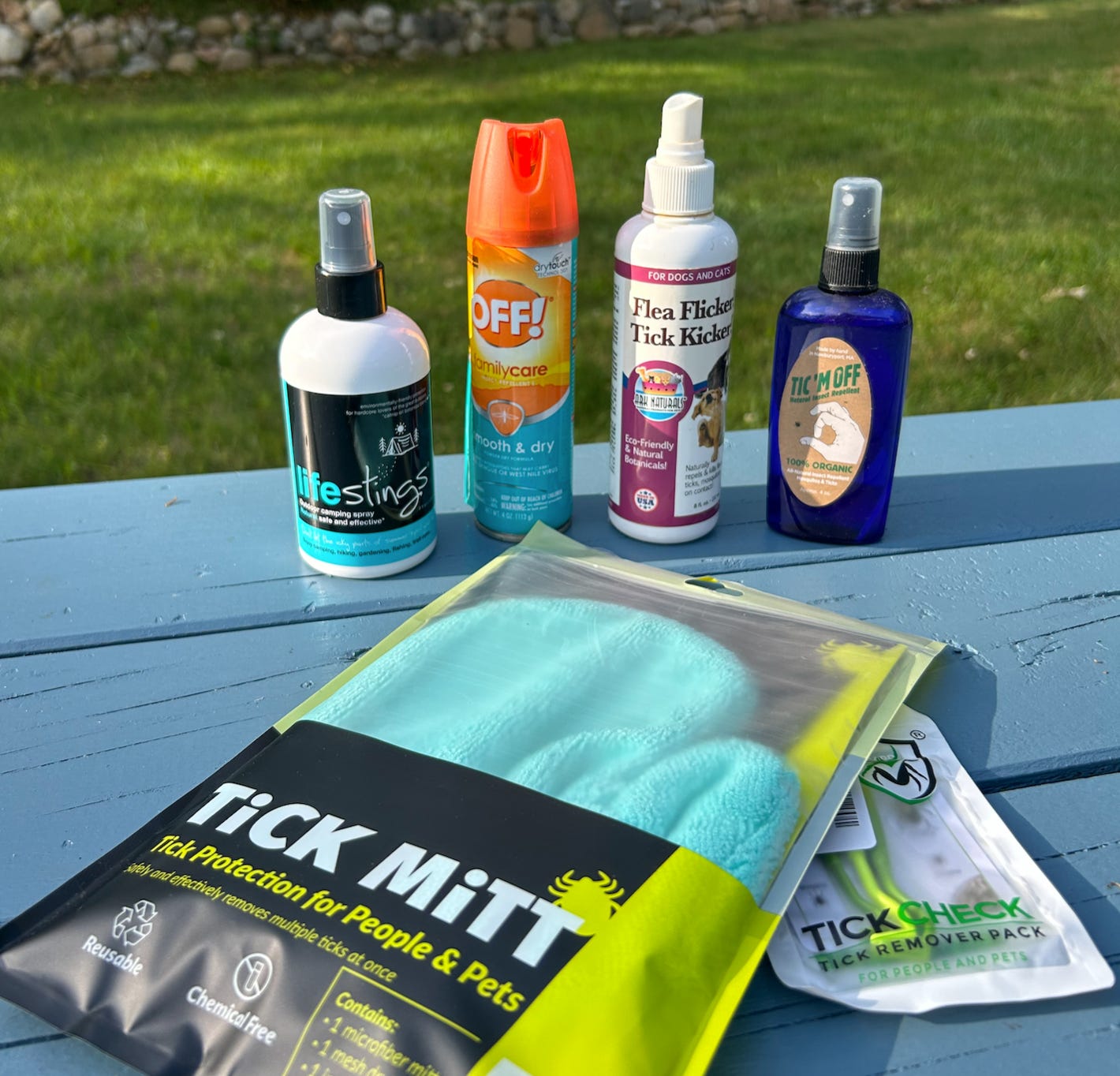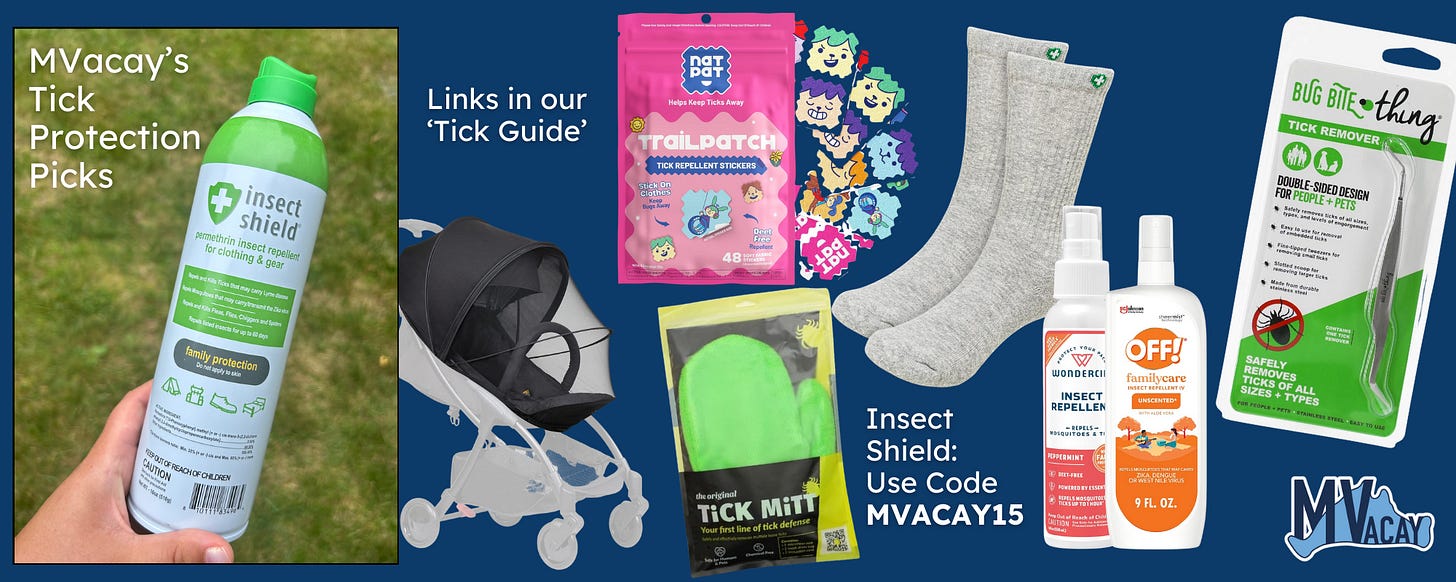🕷️ Ticks on Martha’s Vineyard: What to Know in 2025
What I’ve Learned About Tick Safety, Bites, and Alpha-Gal
I think about ticks every single day. I check my daughters when we come inside. I check myself before bed. I choose where to walk more carefully. I hike less than I used to. This constant vigilance around tick bite prevention has become part of life here on Martha's Vineyard. Tick-borne illnesses, especially Alpha-Gal Syndrome, are a rapidly growing concern for both year-round residents and visitors.
After spending 40+ hours researching protection strategies for my family, I'm sharing what I've learned. This guide comes from personal research and community knowledge, not medical advice. Always consult your healthcare provider for diagnosis, treatment, or questions about your specific situation.
My goal: help you stay safe, act quickly when needed, and reduce your risk of Alpha-Gal Syndrome and other tick-borne illnesses.
What's inside: Prevention tactics (repellents, permethrin, daily habits), post-bite protocols, and resources for those facing an Alpha-Gal diagnosis.
How to Protect Yourself
There’s a lot you can do to lower your chances of a bite!
🧴Apply (and Re-Apply) Bug Spray
Reapplying bug spray matters—especially on long walks. Bring it with you and use it again halfway through.
Which Bug Spray Should You Choose? I talked to several locals to ask for their personal recommendations and compiled them all here. Start by deciding whether you want a DEET-based formula or a DEET-free option. If you're heading deep into the woods or high-risk areas, go with DEET or picaridin. For everyday use or sensitive skin, a natural spray may be all you need.
DEET Options:
DEET remains one of the most effective tick repellents and is widely recommended by public health agencies. Products with 20–30% DEET offer long-lasting protection. Some people avoid it due to its strong smell, potential for skin irritation, or concerns about using it on young children or around pets.
Ben’s 30% DEET Tick & Insect Repellent: Water-based 30% DEET formula, fragrance-free with up to 8-hour protection; best for adults and older kids / $12.27 (3.4 oz)
OFF! Family Care Tick Repellent: 7% DEET, unscented with aloe, gentle protection for short outdoor time and young kids / $9.58 (9 oz)
DEET-Free Options:
DEET-free options use plant-based ingredients that tend to be gentler on skin, safer for pets and kids, and less likely to damage clothing. The tradeoff is that they often provide shorter protection windows and may require more frequent reapplication.
MV Herbal Apothecary makes a natural repellant you can buy on-island.
Cedarcide Extra-Strength Tickshield: Cedarwood and lemongrass oil formula, plant-based / $18.99 (4 oz)
Nantucket Spider Extra Strength Tick Repellent: 100% organic essential oils (cedarwood, rosemary, peppermint), made in the USA / $19.98 (2-pack of 4 oz bottles)
Ranger Ready Repellents Picaridin Tick Spray: 20% picaridin (a DEET-free, odorless compound derived from pepper that repels ticks for up to 12 hours) / $14.99 (5 oz)
Wondercide Tick Repellent (Peppermint): Plant-powered formula with essential oils, safe for babies, pets, and pregnant women / $23.98 (2-pack of 4 oz bottles)
For Babies Under 1 Year: Use stroller netting, dress in long sleeves and pants, avoid grassy areas, do thorough tick checks after walks, and avoid repellents with DEET or picaridin under 2 months.
👕 Wear Permethrin-Treated Clothing + Shoes
Permethrin is a synthetic version of a natural insect repellent found in chrysanthemum flowers. When it’s bonded to fabric, it repels and kills ticks on contact BEFORE they can bite. It’s odorless, invisible, and EPA-approved for use on clothing.
Our family uses Insect Shield spray on our shoes, and we all have Insect Shield socks we wear if we know we’ll be outside for a while. A study on outdoor workers showed that permethrin-treated clothing reduced tick bites by over 90%, and the protection lasts through 70 washes.
Spraying your own clothes with permethrin (like Insect Shield spray or Sawyer) works well, but the treatment typically lasts only about 6 washes. Factory-treated clothing lasts much longer, or you can send your own pieces in to be treated at InsectShield.com (use code MVacay15 for 15% off).
And don’t forget the basics: tuck your pants into your socks and your shirt into your pants when walking through grassy or wooded areas.
🧴 Other Preventative Measures
Some folks swear by using Dr. Bronner’s peppermint soap in the shower
Lint rollers are a go-to after walks—especially on dogs, socks, and cuffs. Locals keep one at each door and in the car. This summer we are keeping the Tick Mitt by our back door before coming inside.
What to wear: Light-colored clothing makes ticks easier to spot during tick checks. Stick to fitted cuffs and closed-toed shoes if you’re in brushy or wooded areas.
Where to avoid: Ticks love shady, damp spots—especially forest edges, animal trails, narrow paths, tall grass, and leaf litter. These areas are high-risk during spring and fall. Stick to the center of wide trails whenever you can (it lowers your risk, though doesn’t eliminate it).
At the beach? Yes, ticks can be there too. Lone star larvae are often found in dune grasses and along beach paths. Stick to sandy areas and avoid grassy edges near dunes.
🐾 For Pets
Pets can carry ticks into the house even if they don’t get bitten. Daily tick checks are a must, especially after walks or outdoor play.
Seresto collars for both dogs and cats—changed every 6 months, not 8.
NexGard or similar oral treatments
Manual tick checks several times a day during peak season using lint rollers - check ears, under collars, and between paw pads.
🚿 After a Walk or Hike
What you do after spending time outside matters just as much as what you wear.
Change your clothes right away and toss them in the dryer on high heat—washing won’t kill ticks.
Shower as soon as you come inside and do a full tick check. Don’t forget: armpits, behind the knees, your waistband, hairline, and behind the ears.
If you keep your clothes on once indoors lint-roll furniture, don’t sit on beds in outside clothes, vacuum high-traffic areas, and keep yard clothes stored separately.
Tick checks are especially important if you’ve been in tall grass, brush, or beach paths with dune grasses.
What To Do After a Tick Bite
Ticks are small, but the diseases they carry can be very serious. Here’s what to do if you find one on you.
🧷 Remove It Promptly
Removal: Use fine-tipped tweezers and pull straight out—don’t twist or crush the tick. Many locals keep a dedicated pair of tweezers, a Tick Key or Tick Remover on hand. Here’s a tick removal guide.
Save the tick: Place it in a sealed bag or tape it to an index card in case you want to send it for testing. This can help determine whether it carried pathogens.
💊 What Locals Do Next
Send it for testing: You can mail the tick to TickReport.com to see if it was carrying any disease-causing organisms.
Ask about medication: Many Islanders keep a standing doxycycline prescription and begin treatment after a bite—especially if the tick was attached for a long time or if it was a nymph. If you don’t already have a prescription, call your doctor right away and explain the situation.
Some use herbal support after a bite (like Ledum, Japanese knotweed, or cat’s claw), but this isn’t medical advice—talk to a practitioner you trust if you're going that route.
Monitor for Symptoms in the Weeks After: Even if a bite seems minor, symptoms from tick-borne illnesses or Alpha-Gal Syndrome can show up days or even weeks later. Watch for rash or hives, fever or chills, joint pain, fatigue, brain fog, nausea, or reactions after eating red meat or dairy.
MV Hospital’s standard Lyme panel does not include Alpha-Gal Syndrome, so you’ll need to specifically ask for that test if you're worried about red meat allergy.
Look at the tick: If it’s a larva (6 legs), it likely doesn’t carry disease but could trigger alpha-gal. If it’s a nymph (8 legs), the risk of Lyme or other illness is higher. Knowing the difference can help you decide whether to seek testing or treatment.
👶 What To Do if a Young Child Is Bit by a Tick
If your child is too young to describe how they feel, you may need to be extra proactive.
Monitor for symptoms like fever, joint pain, swelling, fatigue, or a rash especially a bull’s-eye pattern over the next few weeks. Symptoms can take up to 3 weeks to appear. Don’t rely on immediate signs.
I like Emily Oster’s Decision Tree for Ticks for helping make choices around testing and treatment. I personally have tested all ticks found on my children under age 3.
Check how long the tick was attached: If it was on for less than 24 hours, the risk of Lyme is very low. Still, check with your pediatrician to see what they recommend.
How to Protect Your Yard
Keeping ticks out of your yard isn’t foolproof, but there are a few steps that can make a big difference.
🌿 Tick Prevention Tactics
Locals have a separate set of “yard clothes” that they treat and dry before using.
Use spray with caution—permethrin is toxic to cats, bees, and other beneficial insects, so don’t spray it on skin or near pollinator plants.
Some suggest Cedar Bark Chips around your yard
Remove leaf litter, trim overgrown grass, and keep walking paths wide and clear.
🧯 Yard Treatment Options on MV
People recommend a mix of organic and traditional tick control services:
Brewer Insect & Animal Spraying – standard yard spraying
Yard Defender – all-natural and safe for pets and kids
Pure Solutions – organic spraying (used by the Chilmark Flea Market)
Oh Dear – has worked well for some islanders
This DIY Tick Prevention Spray Option
Thermacell Tick Control Tubes are an easy DIY option. They target mice (a key tick host) and help cut down the population around your yard perimeter.
Tick-Borne Diseases on MV
Martha’s Vineyard is home to several serious tick-borne illnesses, including Lyme disease, ehrlichiosis, babesiosis, and Powassan virus. But the one getting the most attention lately is Alpha-Gal Syndrome—a red meat allergy caused by the bite of a lone star tick.
📊 Why It Matters Here
Lone star ticks are now found in every town on Martha’s Vineyard—not just along the edges or in woodlands. And cases of Alpha-Gal Syndrome have been rising quickly in recent years.
“In 2020, MV Hospital recorded just 2 confirmed alpha-gal cases. By 2023, that number doubled year over year. As of mid-July 2024, 149 Islanders had already tested positive.” — Vineyard Gazette
“Over 250 patients in one island allergy practice.” — Dr. Edward Caldwell
The issue has also gained national attention, with CBS reporting on Martha’s Vineyard as a hotspot in the national rise of alpha-gal cases.
🛒 Managing Alpha-Gal on MV
Most people with Alpha-Gal can safely eat chicken, turkey, fish, and eggs—but everyone’s sensitivity is different. Some people can tolerate a small amount of dairy or butter, while others react to even trace ingredients.
Reading labels becomes second nature. Common hidden triggers include gelatin (often found in medications, gummies, and marshmallows), carrageenan in plant-based milks, and meat-based stocks or “natural flavors” in sauces or packaged foods.
The Fig app makes it easier by you scan products and check whether they’re AG-safe. Many locals also keep a food journal to track which brands or ingredients trigger symptoms over time.
🧑⚕️ Where to Get Support
Adjusting to Alpha-Gal can be overwhelming at first, but you’re not alone and there’s a growing community of support on Martha’s Vineyard.
Josh Levy at Vineyard Nutrition has helped locals transition diets.
An Alpha-Gal Support Group meets occasionally at the Ag Hall, there is also a Facebook Group MV Alpha Gals locally, or this National Alpha Gal group
The MV Tick Program hosts educational talks and Q&As throughout the year.
The VH Library video archive includes recorded talks from MV Tick Program biologists and doctors
🍽️ Eating Out on MV with Alpha-Gal
Not many places advertise AG-friendly menus, but some here are a few local tips:
Seafood-forward restaurants are usually safer than red meat-focused ones
AG-Friendly Offerings Labeled on Menus: You Enjoy My Vegan, Pawnee House, Catboat Coffee, S+S Kitchenette, Pie Chicks, Quitsa Kitchen, The Attic, Mo’s Lunch, The Maker Pasta Shop.
Cook the Vineyard also put together this list of Alpha-Gal Friendly recipes
I hope you learned something new today! The more we know, the better we can protect ourselves, our kids, and our community.
This post includes a few affiliate links. I only share items my family uses and trusts, and affiliate income helps support the research and work that goes into these guides.
Do you have any wisdom or resources to share? Feel free to join one of the groups linked above, or comment on this post.
📌 Reference Graphics


📌 Quick Links
Tick Protection
Insect Shield (use code MVACAY15 for 15% off)
My Order: Insect Shield Permethrin Spray (for Shoes, Pants + Sweatshirts) and Insect Shield Socks (Youth + Adult)










InsectShield will also treat your clothes by the piece or you can fill a bag. I live in treated clothes and shoes now (and tuck pants into socks)- really helps!
This is so excellent. Really valuable information. Thank you for researching and putting this information together! Will share.